
80
HNUE JOURNAL OF SCIENCE
Natural Sciences 2024, Volume 69, Issue 1, pp. 80-89
This paper is available online at http://stdb.hnue.edu.vn
DOI: 10.18173/2354-1059.2024-0008
IDENTIFICATION OF YEAST STRAINS AND FILAMENTOUS FUNGI
IN THE HAI HAU TRADITIONAL ALCOHOL YEAST CAKE
Ho Tuan Anh1,*, Pham Quang Tu1, Vu Van Hanh2 and Hoang Thi Ngoc Anh3
1University of Economics-Technology for Industries, Hanoi city, Vietnam
2Department of Biological Functional Substances, Institute of Biotechnology,
Vietnam Academy of Sciences and Technology, Hanoi city, Vietnam
3AQ Biological Group Company Limited, Hanoi city, Vietnam
*Corresponding author: Ho Tuan Anh, e-mail: htanh@uneti.edu.vn
Received March 9, 2024. Revised March 16, 2024. Accepted March 23, 2024.
Abstract. This study aims to determine the various strains of yeast and filamentous
fungi in traditional alcohol yeast cake from Hai Hau district, Nam Dinh province.
By traditional laboratory techniques such as isolation on YPD agar, observation of
colony morphology as well as cell characteristics by microscopy, combined with
molecular biology method to sequence ITS region 03 strains of yeast
Saccharomyces cerevisiae CN1, CN2, and NM3 were identified: 01 pseudo-strain
yeast Saccharomycopsis fibuligera NM02 and 01 strain of filamentous fungi
Rhizopus microsporus NS04. The density of yeast strains cultured on YPD agar
supplemented with 50 mg/L Tetracycline was 4.5 × 108 CFU/g, while the density
of R. microsporus NS04 filamentous fungi was 2.0 × 106 CFU/g. With the agar
plate diffusion method, yeast strains of S. cerevisiae CN1, CN2, and NM3 that are
unable to biosynthesize extracellular enzymes have been identified. Yeast pseudo-
strain S. fibuligera NM02 is capable of producing amylase (with starch substrate
hydrolysis ring diameter > 9 mm), cellulase (16 mm), and protease (18 mm). The
filamentous fungi R. microsporus NS04 has a higher ability to produce
extracellular enzymes such as amylase (> 9 mm), cellulase (33 mm), and protease
(39 mm).
Keywords: extracellular enzymes, filamentous fungi, Hai Hau, pseudo-yeast, yeast,
alcohol yeast cake.
1. Introduction
The technology of traditional alcohol with yeast cake creates Vietnamese famous
brands, including Hai Hau - Nam Dinh sticky rice alcohol. In light of this, sticky rice is
cooked, allowed to cool on trays, and mixed with traditional alcoholic yeast cake.
After solid fermentation and adding of purified water, the liquid fermentation is carried

Identification of yeast strains, filamentous fungi in the Hai Hau traditional alcohol yeast cake
81
out in a closed container. Most producers in Hai Hau district, Nam Dinh province apply
the fractional method of distillation to remove part of the impurities in obtained alcohol
such as methanol, acetaldehyde, and fusel oil and combine with the maturation process
to create high quality products [1].
Traditional alcohol has unique cultural characteristics of the region. However, the
fermentable efficiency, sanitary conditions, and the quality of alcohol in many locations
are unstable [1]. One of the causes of this instability is the different species of used
microorganisms in traditional alcohol yeast cake. The using of pure and highly active
microorganisms in the fermentation process improves the flavor and aroma of the
finished alcohol [2]. Microorganisms play an important role in the production of
alcohol, directly affecting the productivity and quality of the product. Some common
filamentous fungi species such as Rhizopus, Amylomyces, Mucor, and Aspergillus can
produce extracellular enzymes, and break down starch and other high molecular
components in solid and liquid fermentation. The yeast, which metabolizes fermentable
sugars during the liquid fermentation, includes Saccharomyces cerevisiae, Hansenula spp.,
Endomycopsis spp. [3].
Different types of traditional alcohol yeast cake have been studied by Korean
researchers who have identified differences in the composition of volatile substances
such as methanol, high alcohol, and esters in the finished alcohol [4]. A similar
conclusion was also published by scientists from China [5]. Increasing the recovery
efficiency was performed by Cambodian and Philippine experts through improving
cooking, fermentation, and distillation techniques [6].
The purpose of this research was to isolate and identify yeast and filamentous fungi
strains in Hai Hau alcohol yeast cake, to determine the activity of their extracellular
enzymes. Experimental results can be used as a scientific database to develop new
alcoholic beverages from Hai Hau sticky rice alcohol.
2. Content
2.1. Materials and methods
2.1.1. Materials
The studies were conducted at the Department of Biological Functional Substances,
Institute of Biotechnology, Vietnam Academy of Sciences and Technology.
The research object was to use alcohol yeast cake from Hai Hau district, Nam Dinh
province for producing traditional alcohol by people themselves. The cake production
process includes the steps of grinding rice into flour, mixing rice flour with water and
alcohol yeast cake starter, shaping, incubation for propagation, and drying.
The used equipment includes a microscope Nikon YS100 (America), centrifuger
Hittich MIKRO 185 (Germany), shacking incubator Wise Cube (China), autoclave
Tomy ES 315 (Japan), electronic weigher (Vietnam), counting chamber Neubauer
(Germany) and some other tools for analyzing and identifying microorganisms by
PCR method.
Basal culture medium YPD agar (yeast peptone dextrose) g/l includes yeast extract 10,
peptone 10, glucose 20, agar 20, pH 7.

Ho TA*, Pham QT, Vu VH & Hoang TNA
82
The amylase activity of the strains was expressed by the difference in clear zone
diameter and the diameter of the hole D-d (mm) on agar medium, supplemented with
1% starch. The cellulase activity - supplemented with 1% Carboxyl Methyl Cellulose
(CMC) and protease activity to produce casein hydrolytic enzymes - supplemented with
1% casein substrate. The culture medium was sterilized at 121 °C for 20 minutes before
being poured into a petri plate.
2.1.2. Methods
Isolation of filamentous fungi and yeasts: The sample of 10 g traditional alcohol
yeast cake was resuspended into 90 ml of sterilized water and 10-fold serial dilutions
were performed (10-2 - 10-6). The volume of 100 µL from each diluted sample was
spread on yeast peptone dextrose (YPD) agar medium for 7 days at 25 °C. Colonies
with different morphotypes were picked on YPD agar medium and then incubated under
the same condition.
Macroscopic study: The morphology of yeasts and filamentous fungi and their
appearance on YPD medium was examined based on their cultural characteristics
(colony form, elevation, margin, appearance, pigmentation, optical property, and
texture).
Method for determining microbial colony density (CFU/g): Filamentous fungal
colonies were counted directly on a petri plate.
Method for determining yeast cell density (CFU/mL): Determined by using a
Neubauer chamber.
Conservation method: Pure strains of the selected strain after identification are
preserved in saline water with 30% glycerol supplement, stored at -80 °C.
Methods for determining extracellular enzyme activity: The pure strain was grown
in YPD medium and shaken at 150 rpm at 30 °C for 1 day, 2 days, 3 days, and 4 days; a
sample of 50 µL of fermentation liquid was aspirated and centrifuged at 5,000 rpm for
15 minutes; the supernatant was tested for extracellular enzyme activity using the agar
plate diffusion method.
DNA extraction from pure yeast strains (Kit Pathogen Ultra Nucleic Acid Isolation
by Thermo ScientificTM, USA).
Total DNA was extracted according to the method of Kurtzman & Fell (1998) with
some suitable modifications for the laboratory [7]. The volume of 1 mL liquid
fermentation (24 h for yeast, 72 h for filamentous fungi) was taken into an Eppendorf
tube and centrifuged at 10,000 rpm for 5 minutes; the supernatant was removed and the
residue was collected. After that, 100 μL TE buffer, and 5 μL RNAase were added and
followed by incubation at 37 °C for 30 minutes; after adding 500 μL solution 1 (DNA kit)
the procedure was continued with incubation at 70 °C for 10 minutes and cooling the
obtained sample. After 700 μL chloroform was added and centrifuged at 10,000 rpm for
5 minutes, the volume of 400 μl supernatants was transferred to new eppendrof tubes,
containing 800 μL solution (including 80 μL of solution 2 and 720 μL deionization
water). The obtained sample was centrifuged at 10,000 rpm for 5 minutes. After the
supernatant was removed, the residue was mixed with 150 μL of solution 3 (DNA kit); a
volume of 450 μL absolutely anhydrous alcohol was added and the sample was

Identification of yeast strains, filamentous fungi in the Hai Hau traditional alcohol yeast cake
83
centrifuged at 10,000 rpm for 10 minutes. DNA pellets were washed with 500 mL of
70% ethanol, and tubes were centrifuged at 10,000 rpm for 15 minutes. The ethanol was
discarded, and the pellets were dried at room temperature for 45 - 60 minutes. Finally,
the DNA was resuspended in 20 μL of elution buffer and stored at -20 °C until sent for
analysis. In order to check DNA extraction, an electrophoresis on agarose gel was
performed.
PCR method: For PCR amplification, 1 µL of the genomic DNA was used as a
DNA template. A pair of two fungal universal primers for internal transcribed spacer
region (ITS) including ITS1 (5’-TCC GTA GGT GAA CCT GCG G-3’) and ITS4
(5’TCC TCC GCT TAT TGA TAT GC-3’) were used for molecular identification.
DNA sequence: The DNA sequences of the potential fungi were compared with
reference sequences available in NCBI GenBank (http://www.ncbi.nlm. hih.gov/blast).
Construction classification tree: A phylogenetic tree based on ITS regions was
constructed using MEGA7 Software based on Neighbor Joining (NJ) method according
to Kimura (1980) using Saitou's and Nei's methods. (1987).
Statistical analysis: The experimental data were processed using the Microsoft
Excel 2013 software.
2.2. Results and discussion
2.2.1. Isolation and determination of the density of yeast, filamentous fungi
The results from the isolation process of microorganisms in Hai Hau traditional
alcohol yeast cake samples on YPD medium supplemented with Tetracycline antibiotic
(50 mg/L) and YPD without antibiotic were shown in Figure 1, the cell density of yeast
and filamentous fungi was presented in Table 1.
A
B1
B2
Figure 1. Morphological characteristics of strains isolated and grown
in the A: YPD with Tetracycline antibiotic; B1 and B2: Antibiotic-free YPD medium
For the alcohol yeast cake samples on the YPD plate with antibiotic
supplementation, it was shown that yeast cell density, molds began to appear after 3
days of breeding and then grew stronger in later days (Figure 1A). The density of yeast
and mold cells after 3 days of breeding was 4.5×108 and 2.0×106 CFU/g, respectively.
For alcohol yeast cake samples isolated on non-antibiotic YPD plates, the yeast density
reached 4.9×108 and 2.0×106 CFU/g after 3 days of breeding, respectively (Table 1),
and then grew stronger in subsequent days. (Figures B1 and B2).
By observing the morphology of colonies on YPD agar medium and cell structure
under a microscope 05 characterized colonies were selected, including 04 colonies
similar to yeast and 01 colony of filamentous fungi.

Ho TA*, Pham QT, Vu VH & Hoang TNA
84
Table 1. Density (CFU/g) of yeast, Filamentous fungi isolated
from Hai Hau alcohol yeast cake
Microorganism
Culture medium
YPD (with antibiotics)
YPD (non-antibiotics)
Yeast (CFU/g)
4.5 × 108
4.9 × 108
Filamentous fungi (CFU/g)
2.0 × 106
2.0 × 106
The colonies continued to be cultured on YPD agar medium to obtain pure forms
and followed a description of obtained morphology characteristics. The results are
presented in Table 2.
Table 2. Morphological characteristics of selected strains of yeast, pseudo-yeast,
and filamentous fungi
Strain
The figure of colonies, cells
Morphological characteristics
CN1
The colony was round, milky
white, with a characteristic
aroma; the cells were spherical,
reproducing by budding (Strain
yeast S. cerevisiae CN1)
NM02
The colonies were round with a
characteristic aroma; the cells
were spherical and attached to
filaments (Strain
Saccharomycopsis sp. NM02)
CN3
The colonies were small, round,
and milky white with
characteristic aroma, and the cells
were egg-shaped, reproducing by
budding (Strain yeast S.
cerevisiae CN3)
NS04
Grown as filamentous, branching
hyphae lacked cross-walls.
Colonies were initially white, then
darker, and gradually turned
black. The sporangiophores were
round (Strain Rhizopus sp. NS04)
NM3
The colonies were round, had
smooth surfaces, were milky
white, had a characteristic aroma,
and had oval cells, reproducing
by budding (Strain yeast S.
cerevisiae NM3);


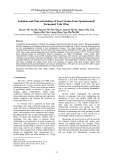
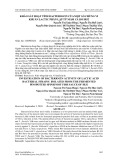
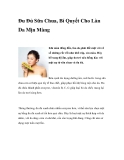
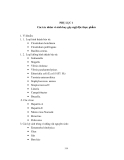
![Vi Sinh Vật Nhiễm Tạp Trong Lương Thực - Thực Phẩm Phần 3: Tổng Quan [Chuẩn SEO]](https://cdn.tailieu.vn/images/document/thumbnail/2011/20110626/thitkhotieu/135x160/15409_thuvienso_info00003_8365.jpg)
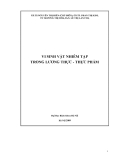


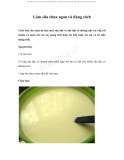






![Bài giảng Chế biến khoáng sản vô cơ [Mới nhất]](https://cdn.tailieu.vn/images/document/thumbnail/2025/20251025/thanhvan173002/135x160/21521761538638.jpg)








